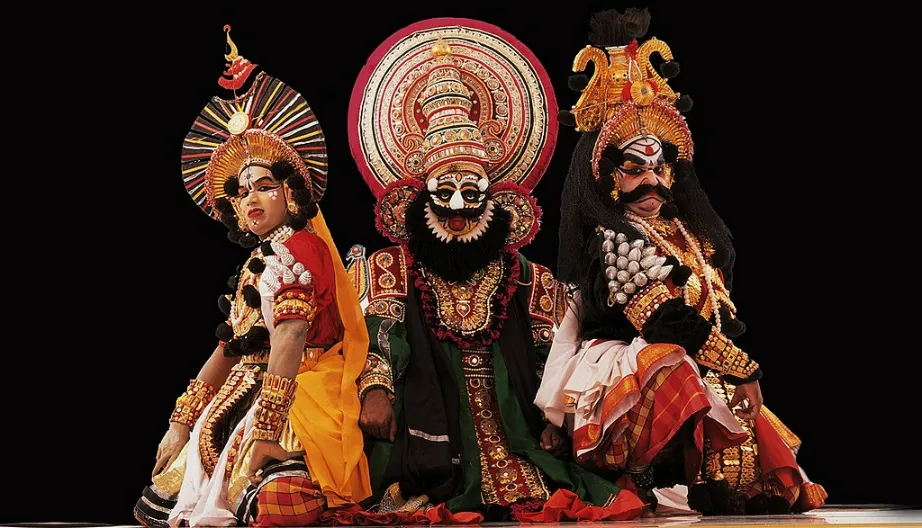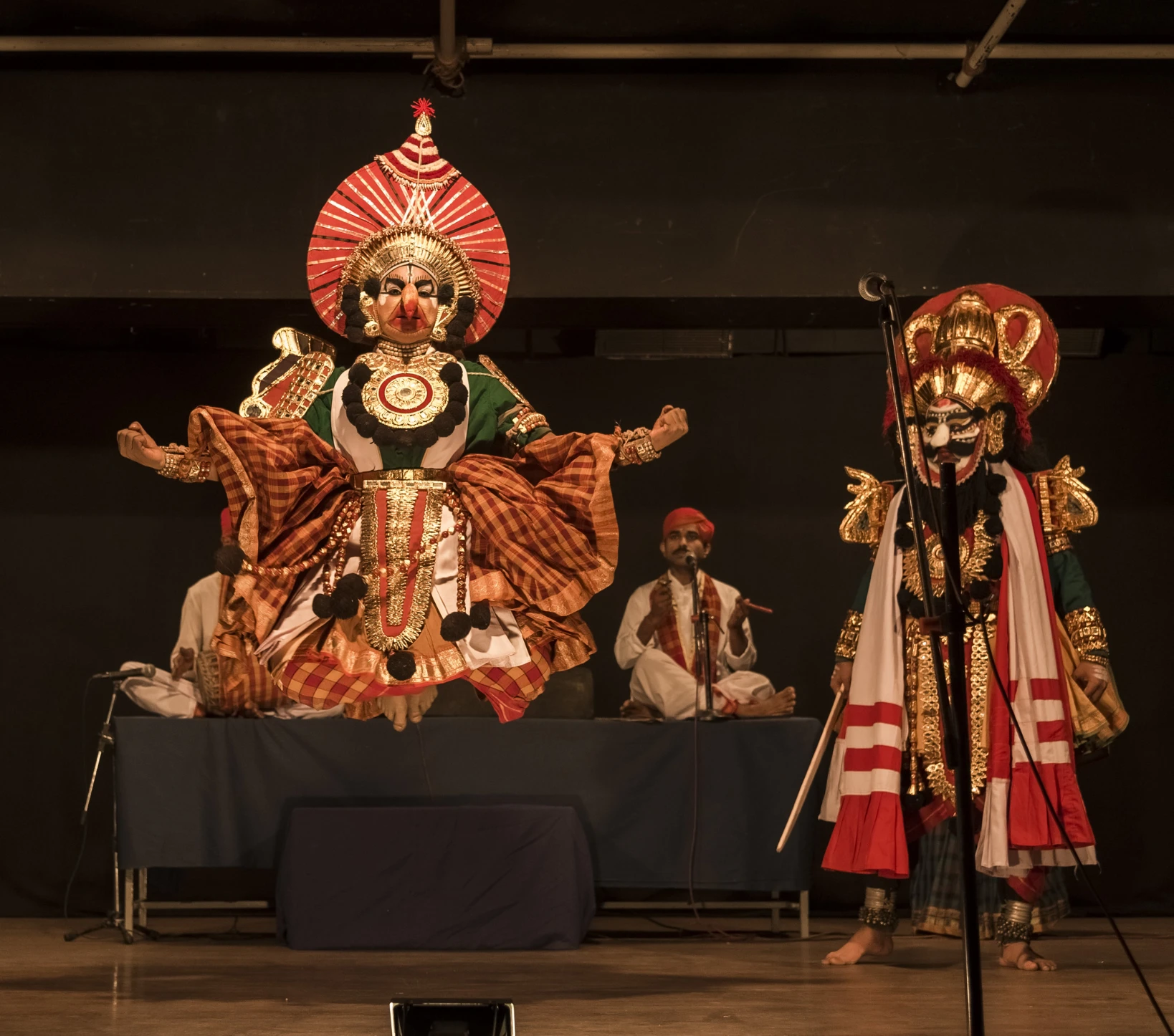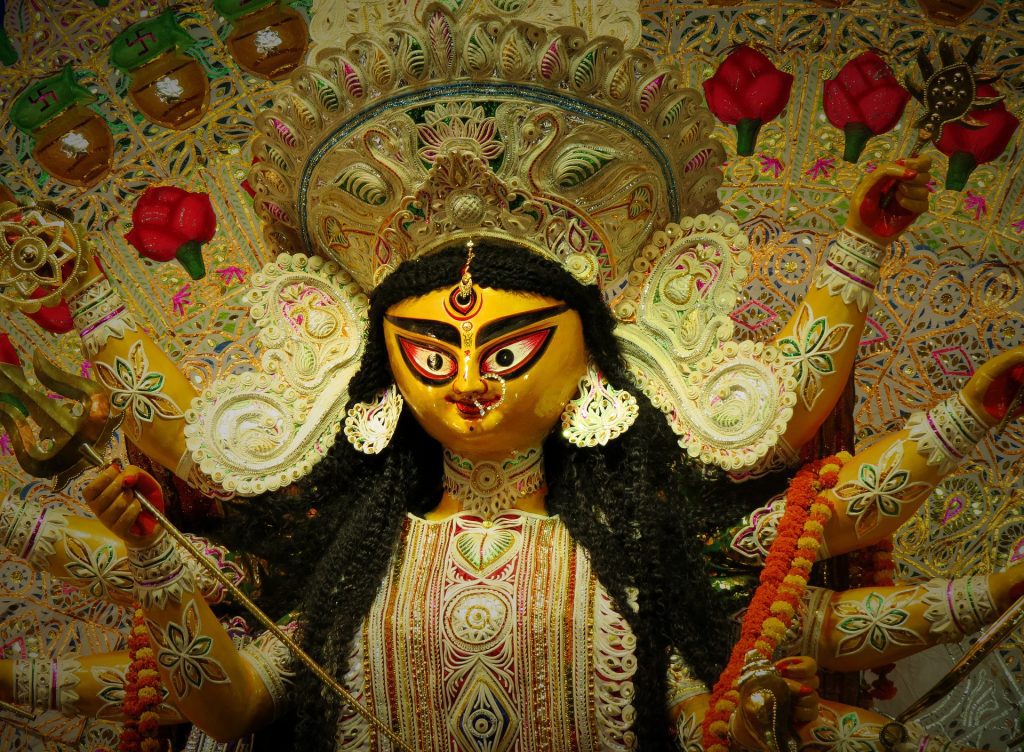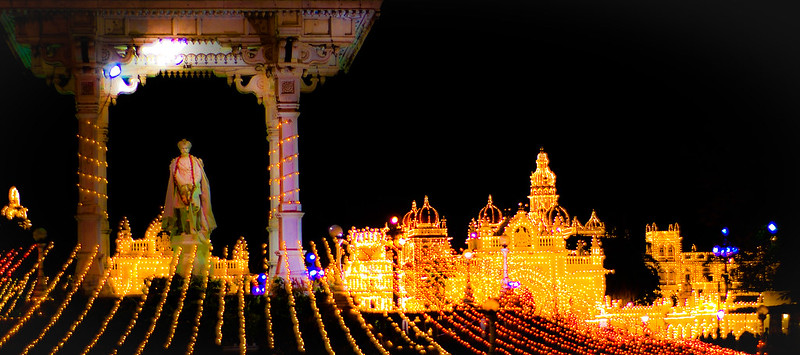India, a tapestry of rituals, terrains, and artistic treasures, cradles myriad places dedicated to preserving these cultural gems. Among them shines Yakshagana, Karnataka’s luminous traditional theatre, bearing witness to the state’s profound cultural legacy. It’s a spectacle that, in its grandeur, parallels the magnificence of Broadway or the opera. Through a mesmerizing fusion of music, dance, dialogue, and ornate costumes, Here, families have been passing down the art of Yakshagana from one generation to the next in villages.
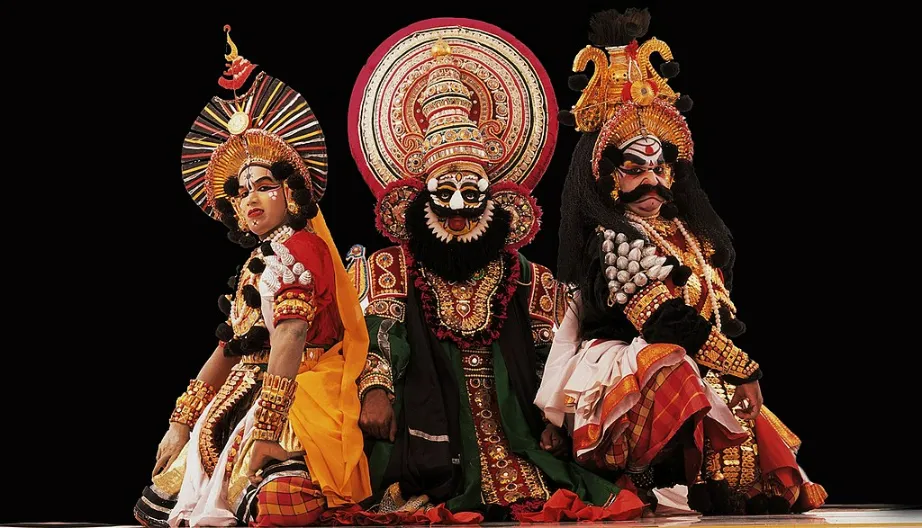
In the heart of Karnataka, nestled within the Honnavar taluka of Uttara Kannada district, lies a village named Gunavante. This village isn’t just any ordinary settlement; it stands as a beacon of tradition, dedicated to the preservation and propagation of the ancient art form of Yakshagana. At the forefront of this cultural preservation is Guru Keremane Shivananda Hegde. Not just an artist, but a legacy bearer, he is the fifth in his lineage to master and promote Yakshagana.
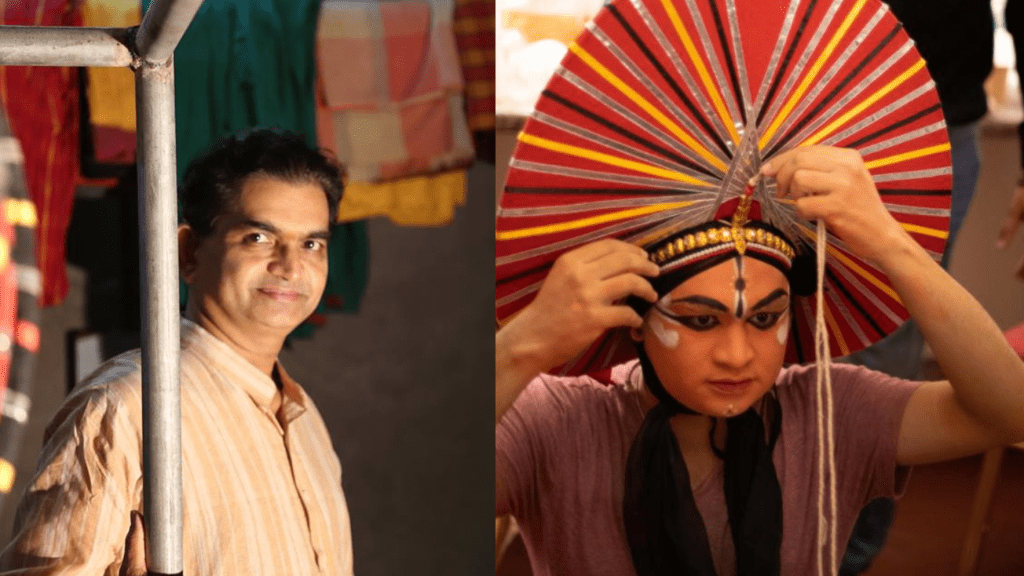
In Gunavante, Hegde runs a Gurukula, an ancient Indian residential schooling system, where students immerse themselves in the world of Yakshagana. Under his tutelage, they not only learn the intricate steps and rhythms but also the philosophy and history behind this art form. But Hegde’s mission isn’t confined to the boundaries of Gunavante. With his troupe of dedicated artists, he travels across India, showcasing the mesmerizing performances of Yakshagana. Through these tours, he hopes to spread awareness and kindle an interest in this age-old art form, ensuring that it continues to thrive in the modern age. His son Keremane Shridhara Hegde (natanayaksha) continues to support his father in these endeavours along with new ideas for the larger missions of the Mandali namely –
- SHIKSHANA (Education)
- RAKSHANA (Preservation and Propagation)
- SAMVARDHANA (Creative Exploration and Development of Yakshagana and allied art forms)
But what sets Hegde apart is his unique background. Before delving deep into the world of Yakshagana, he pursued neuroscience. You can comfortably experience the art form in Gunavante by booking a Savaari from Bangalore. In this article, we embark on a journey through the annals of Yakshagana, from its ancient roots to the intricate details that make it the mesmerizing spectacle it is today with his musings.
Gunavante – The heartland of Yakshagana and a family legacy

In the heart of Karnataka, nestled within the Uttara Kannada district, lies a village named Gunavante where we have a Gurukula dedicated to the art of Yakshagana. The Gurukula has been around for over 36 years. In the past, students would live with the artists, especially during the rainy season when travel was tough. They’d learn the art while living with these performers. As time went on, my grandfather had the idea to establish a dedicated school for this art.
About 30-40 years ago, he bought a 2-acre plot in Honnavar and started a small Gurukula. This was the beginning of a more formalized training structure. Initially, there was one such school in Udupi, and then in Gunavante. Students would start by learning the basics and then join touring groups, playing minor roles. This model of moving from village to village is called “tirugata.” Other theatre schools have since adopted this approach. The Gurukula ensures they have full-time musicians. Over the years, it has attracted students not just from local areas but from all over India, who come and stay for 6-7 months to get introduced to this vibrant art.

Tracing the roots of a Yakshagana
With roots in Sanskrit literature and theatre, Yakshagana emerged between the 11th and 16th centuries in coastal Karnataka and some parts of Kerala. The name “Yakshagana” translates to “songs of the Demi-Gods/celestial beings/wild-spirits.” This dance tells stories through a mix of songs, dance, and spoken words, mostly based on the poems of Yakshagana. It was inspired by the Vaishnava Bhakti movement that started in the 11th century.
It took the format of dance drama under Vijayanagara empire in central Karnataka. After the collapse of the empire, it spread out in all of south India, especially to the west coast where it flourished in its originality.
The main stories in Yakshagana come from the Hindu tales of Ramayana and Mahabharata. At first, it was a way to share these stories in temples. But over time, it grew into a full theatre performance with professional artists. The dance now includes music, drama, and expressive movements that make the old myths come alive. With lively footwork and dance moves, it keeps the audience hooked from start to finish.
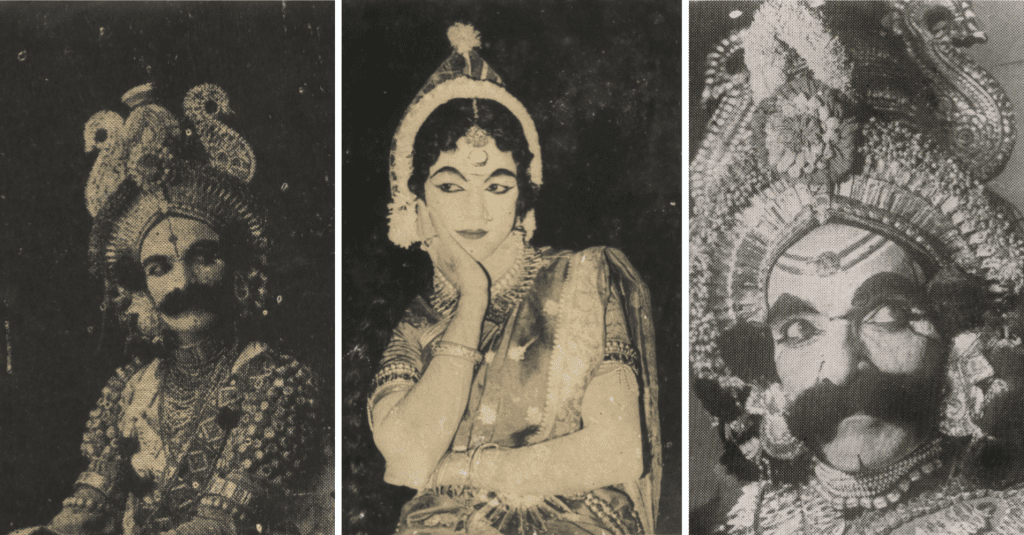
Legends and folklore of Gunavante
The coastal region is dotted with temples, each having its associated troupes that carry specific stories linked to the temple’s deity or history. These troupes play a crucial role in disseminating local tales, often intertwining them with broader narratives. For instance, the story of “Maruthi Pratapa” isn’t found in the major epics like Ramayana or Mahabharata but was penned by a local poet; it is the interesting common point between the two epics as the character of one gets into a situation in the other epic. Such stories, rooted in local beliefs and traditions, often find their way into Yakshagana performances.
However, it’s essential to understand that Yakshagana doesn’t aim to depict historical accuracy. The format thrives on fantasy, much like Shakespearean tales. It’s not about recreating real events but transporting the audience to another realm. This is why mythological tales, fantasies, and even stories from other cultures when adapted, fit seamlessly into the Yakshagana narrative. The art form’s essence lies in its ability to create otherworldly experiences, populated by fantastical creatures and tales of valour, love, and morality. In this vibrant tradition, the dialogue of the play is improvised, as is the dance, expressions, and drama. This improvisation sparks a conversation with age-old stories, making them relevant to spectators who witness it time and again.
Blending cultures and overcoming differences in Gurukula
In the initial days, our Gurukula faced resistance from traditionalists within our village. They were uncomfortable with the idea of students from various castes, both upper and lower, being treated equally. My grandfather, however, was adamant about ensuring equality among all students and resisting any form of discrimination.
Today, the Gurukula is a melting pot of cultures. Students from Gunavante and those from outside blend seamlessly. The primary challenge they face is the language barrier, with some students from the north speaking Hindi and the locals communicating in Kannada. However, the enthusiasm to learn bridges this gap. Many students, captivated by the local culture, make an effort to learn Kannada and immerse themselves in the traditions of the region. The shared passion for Yakshagana and the spirit of unity fostered by my grandfather’s principles have created a harmonious environment where everyone learns and grows together.
Balancing Tradition and Modernity in Yakshagana
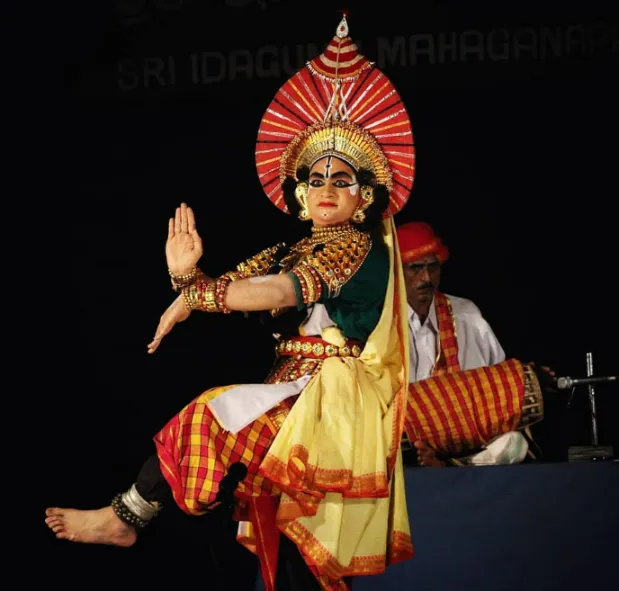
Yakshagana is a dynamic art form, with many of its elements being spontaneous and created on the spot. While we have overarching stories and poems that date back 300 years, much of what unfolds on stage is improvised. We might be narrating tales from mythology, but the challenge lies in making them resonate with today’s audience.
Yakshagana isn’t just about narrating stories; it’s about reinterpreting them. Audiences are already familiar with the tales of Rama, Sita, and Krishna. They come to our performances not just to hear these stories but to witness our unique vision and portrayal of the characters. It’s this retelling, with layers of interpretation and personal experiences, that keeps the art form alive and relevant.
Every performance is influenced by the current socio-political environment, our personal experiences, and the cultural milieu we’re part of. For instance, while I’ve never met mythological figures like Draupadi or Sita, I’ve been influenced by the strong women in my life, like my mother and partner. Their conversations and their experiences shape my portrayal of characters on stage, making each performance unique.
We view Yakshagana as a language, that uses its traditional elements to craft narratives. But when performing for audiences unfamiliar with our stories or culture, like those in Delhi who might not understand Kannada, we adapt. We lean more into storytelling, ensuring the essence of the tale is communicated. My grandfather always emphasized the importance of improvisation, ensuring that while the core of the story remains intact, it’s presented in a way that’s relatable to diverse audiences.
Styles and Variations of Yakshagana
Yakshagana isn’t just a singular art form; it’s an umbrella term encompassing various sister art forms found across coastal Karnataka, Andhra Pradesh, Tamil Nadu, and Kerala. Specific to the coastal and Western Ghats regions, there are two primary styles: the southern style, known as “Thenku Thittu,” and the northern style, “Badaga Thittu.” The demarcation roughly starts from Udupi, with the northern style extending up to Uttara Kannada. These styles differ in their costumes, dance movements, and improvisation of dialogues, each carrying its distinct regional flavour.
In the southern coastal region of Karnataka, there’s a unique tradition where performers, during the off-season, move from one house to another, showcasing their art in full costume. We also have the tradition of Yakshagana puppetry. Another variation is “Yakshagana Thalamaddale,” where performers don’t don costumes but immerse themselves in characters, engaging in a musical discourse of improvisation.
The Journey of Age and Mastery
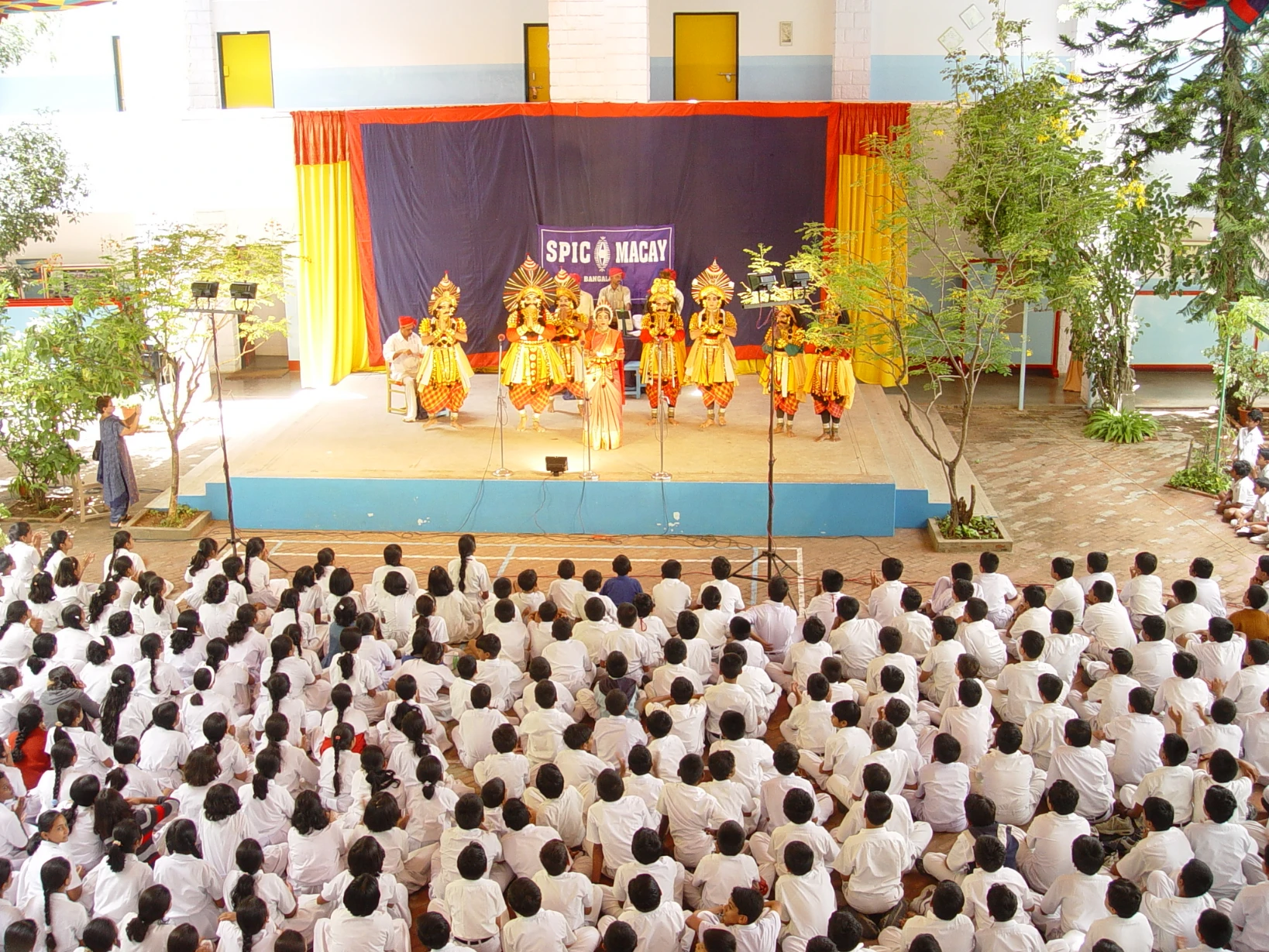
The criteria for joining our Gurukula is simple: an interest to learn. While it’s beneficial for students to know how to read and write, it’s their passion that truly matters. I recall a recent workshop where a 65-year-old woman participated, showcasing her dedication to learning Yakshagana. This art form is not just about dance and drama; it delves deep into expressions, Indian epics, mythology, and poetic dramatology.
Age and socio-economic conditions have always influenced the decision to join the Gurukula. Four decades ago, Yakshagana wasn’t as respected as it is today. We often had students from rural backgrounds, dropouts, or those who couldn’t fit into regular jobs. Many couldn’t read or write, but my grandfather took it upon himself to educate them.
Today, the scenario is different. Most students are educated and decide to join us in their adulthood. Young children often visit during weekends, while older students, typically after their 10th grade, can fully dedicate themselves to the art. However, the number of students wanting to pursue Yakshagana full-time is decreasing. We’ve implemented scholarship schemes and financial support to retain them. But, interestingly, while the total number remains constant, we see an influx of students from different parts of India, many aspiring to be actors. Their interest in this art form is growing, and that’s a silver lining for us.
Yakshagana: Unfolding its Core Elements
Yakshagana is a dance form that’s rich in tradition and is performed to honour the Gods. To successfully stage a Yakshagana performance, several components come together to create a mesmerizing experience for the audience:
- Artists of Yakshagana Dance: The heart of any performance lies in its artists. Yakshagana artists are dedicated professionals who deeply embody their roles. Traditionally, all-male troupes danced, with men portraying female characters with grace and finesse. However, modern troupes have evolved to include women, and there are even all-women Yakshagana groups today.
- Facial Makeup of Yakshagana Dance: Expressions play a pivotal role in theatre. The intricate facial makeup in Yakshagana helps artists convey emotions and stories more vividly. Using natural dyes, the makeup is inspired by visuals and sculptures, with specific designs tailored to each character’s role.
- Headgear and Costumes of Yakshagana Dance: Indian folk dances are renowned for their vibrant costumes and elaborate headgear. In Yakshagana, the headgear, known as “Yakshagana Pagade,” is custom-made for each performer. The costumes, equally colorful and detailed, are tailored based on the character being portrayed.
- Music of Yakshagana Dance: Live music is integral to Yakshagana, enhancing the authenticity of the performance. Instruments like the flute, drum, harmonium, cymbals, and Maddale (a type of drum) are used. The dance is particularly known for its unique blend of cymbals and Maddale, which creates a distinctive rhythm.
- Plot: The narrative is the backbone of the performance. Yakshagana primarily draws its stories from the Indian epics, Ramayana and Mahabharata. Performers enact specific scenes from these epics. While traditionally these performances could last the entire night, modern renditions are usually condensed to under three hours.
Teaching Yakshagana: A Journey Beyond Black and White
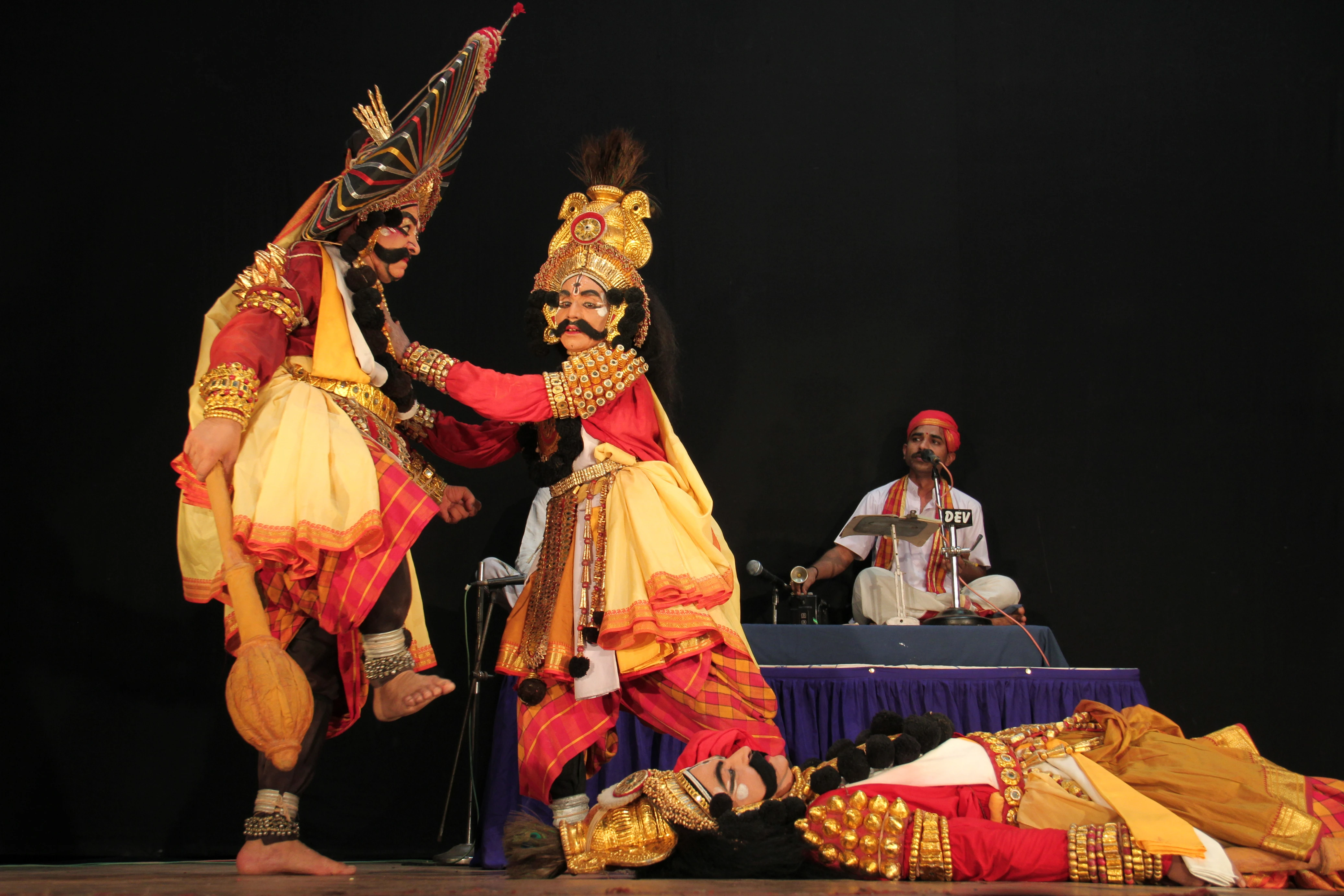
When introducing the younger generation to Yakshagana, I emphasize the depth and complexity of our mythology. Our stories are rich and varied, presenting a plethora of characters and situations that anyone can relate to. However, in Yakshagana, things aren’t simply black and white.
While many traditional tales might present a straightforward battle between good and evil, our narratives delve deeper. Take the character of Ravana, for instance. On the surface, he might be labelled as a demon or a villain. But in our performances, we explore his humanity, prompting performers and audiences to question his motivations and actions.
A prime example is the story of Vali and Sugriva from the Ramayana, which takes place in Hampi in modern-day India. When Rama, coming from Ayodhya, gets involved in their conflict, he doesn’t confront Vali directly. Instead, he hides and shoots an arrow at him. This act raises many questions. How could Rama, revered as a godly figure, resort to such a covert act? In our performances, we challenge Rama’s character to justify his actions. This approach often leads audiences to empathize with characters like Vali, even if they’re traditionally portrayed as antagonists.
In teaching Yakshagana, I stress that narratives shouldn’t be oversimplified. Villains aren’t just evil entities to be vanquished. Every character and every action has layers of meaning and motivation. Our exploration of these stories is collective and open-ended, encouraging students to think critically, question, and engage deeply with the narratives. This approach not only enriches their understanding of the art form but also equips them with a nuanced perspective on life and its complexities.
Behind the Curtains: Setting the Yakshagana Stage
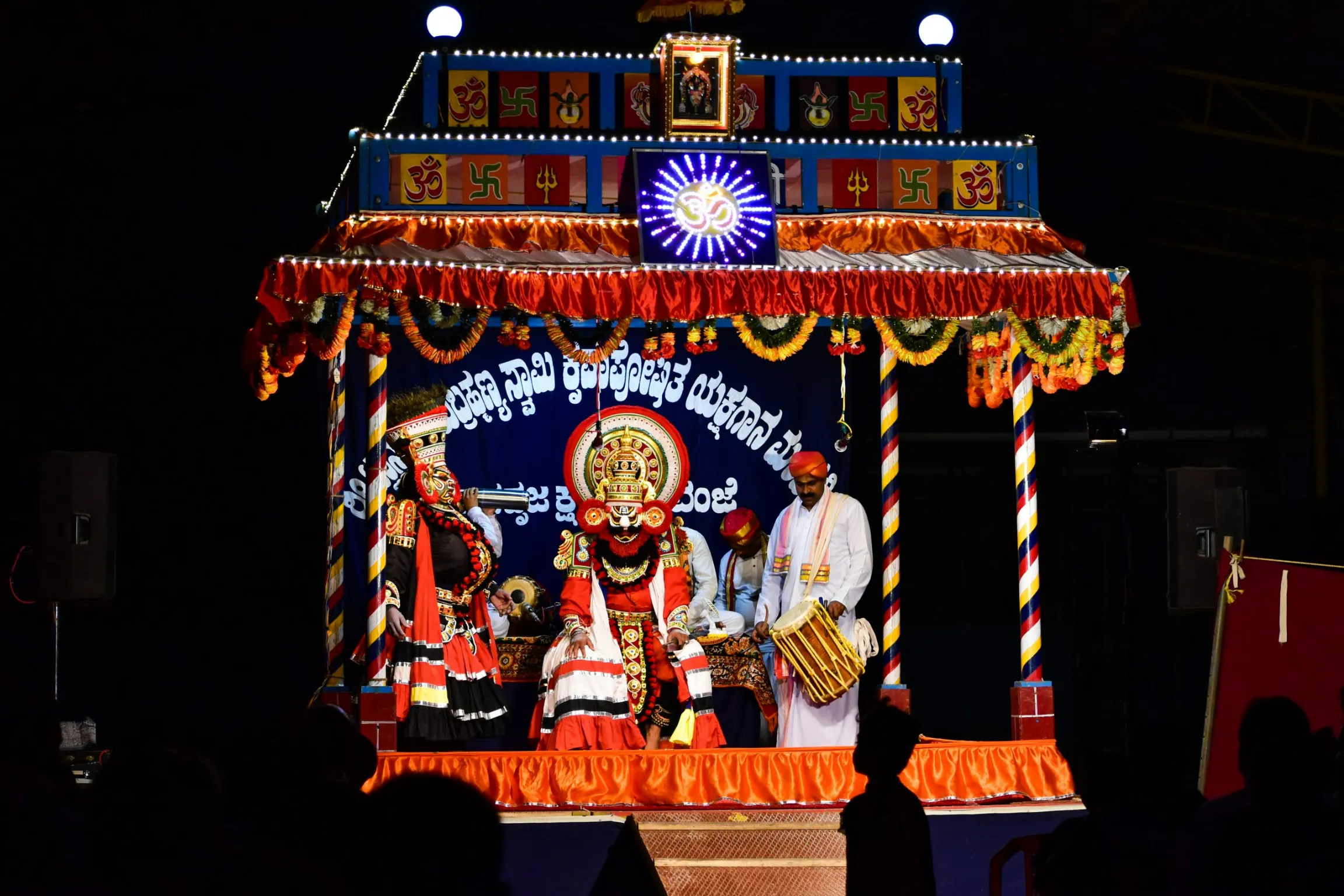
Yakshagana, with its vivid facial expressions, captivating dialogues, and graceful dance moves, offers a unique theatrical experience. Its distinct staging further elevates its charm.
Set against the backdrop of a starlit sky, Yakshagana is a visual delight, characterized by its colorful costumes, detailed makeup, and rhythmic beats. The costumes and makeup play a pivotal role in character identification. For instance, red and black makeup typically signifies a demonic character, while a hero is distinguished by a pinkish-yellow face, a pronounced forehead mark, and a teardrop-shaped turban. However, these costume codes can vary regionally.
The ambience is electrified by the echoing drumbeats and the entrancing recitation of songs and mantras, immersing the audience in the narrative. The performance commences with the Bhagavatha, the lead singer, invoking divine blessings. This act is more than just a ritual; it’s a heartfelt request for a successful and blessed performance. As the story unfolds, characters spring to life, with the Bhagavatha offering a live commentary, steering the audience through the tale.
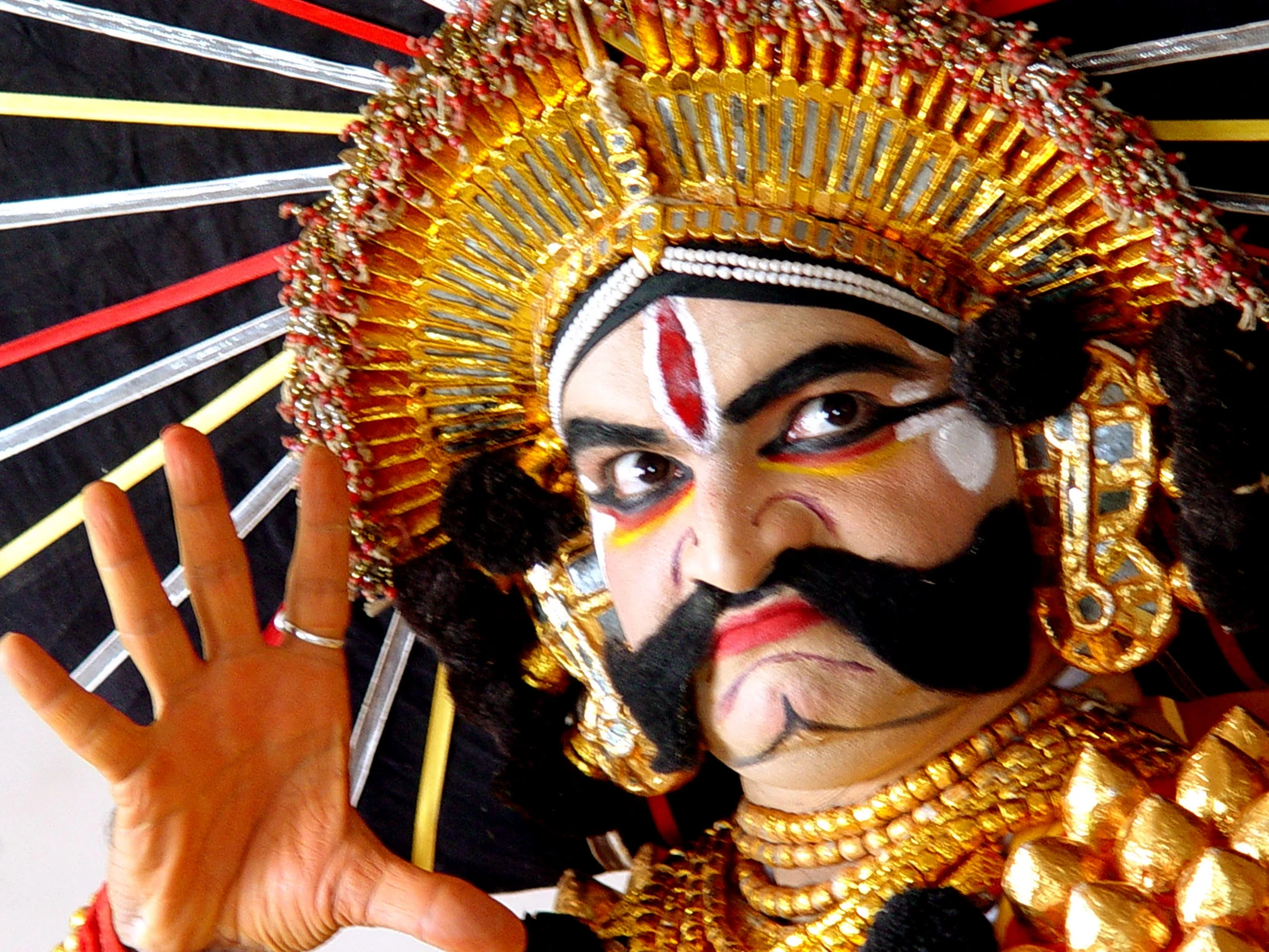
The actors’ performance is a blend of scripted and improvised lines, with cues taken from the lead musician or bhagavatar, who essentially orchestrates the show. In Karnataka, the bhagavatar sets the scene by singing and narrating, typically accompanied by a small gong or finger cymbals known as tala. Some ensembles might include both. The rhythmic essence is delivered by two drummers: one playing the hand-struck maddale and the other the stick-beaten centa. A harmonium typically provides a melodic base, and in certain performances, additional singers might support the bhagavatar.
Historically, Yakshagana performances would last the entire night. However, in keeping with modern times, they’ve been shortened to span just a few hours. This change hasn’t diminished the dance’s essence or quality. The vigour of the dance steps, the harmony of the live music, and the articulate dialogues persistently enchant audiences, preserving the enduring allure of Yakshagana.
Gunavante’s Involvement in the Gurukula
The residents of Gunavante are deeply involved in the activities of the gurukula and Yakshagana performances. They consistently show their support, attending meetings and actively participating in various events.
While many locals are already familiar with the art form, they remain enthusiastic whenever new and engaging activities are organized. Their presence and encouragement are vital to the gurukula’s success.
The Keremane Shambhu Hegde National Performing Arts Festival
The presence of the gurukula and its activities have brought tangible benefits to Gunavante. One of the most significant events is the “Keremane Shambhu Hegde National Performing Arts Festival,” held every February. This festival, initiated in honour of my grandfather after his passing, invites artists from all over India. With performances spanning five days, it draws a footfall of around 2,000 people every evening. Such a gathering is rare in rural areas, which typically only witness local art forms.
The festival not only showcases the richness of Indian arts, many of which originated in villages but also provides a platform for local businesses. Vendors selling special handlooms from the Western Ghats, booksellers, and other local entrepreneurs find a ready audience. The influx of visitors also benefits local lodges, which accommodate artists and attendees. Many visitors choose to stay within the village to fully experience the festival, further boosting local businesses.
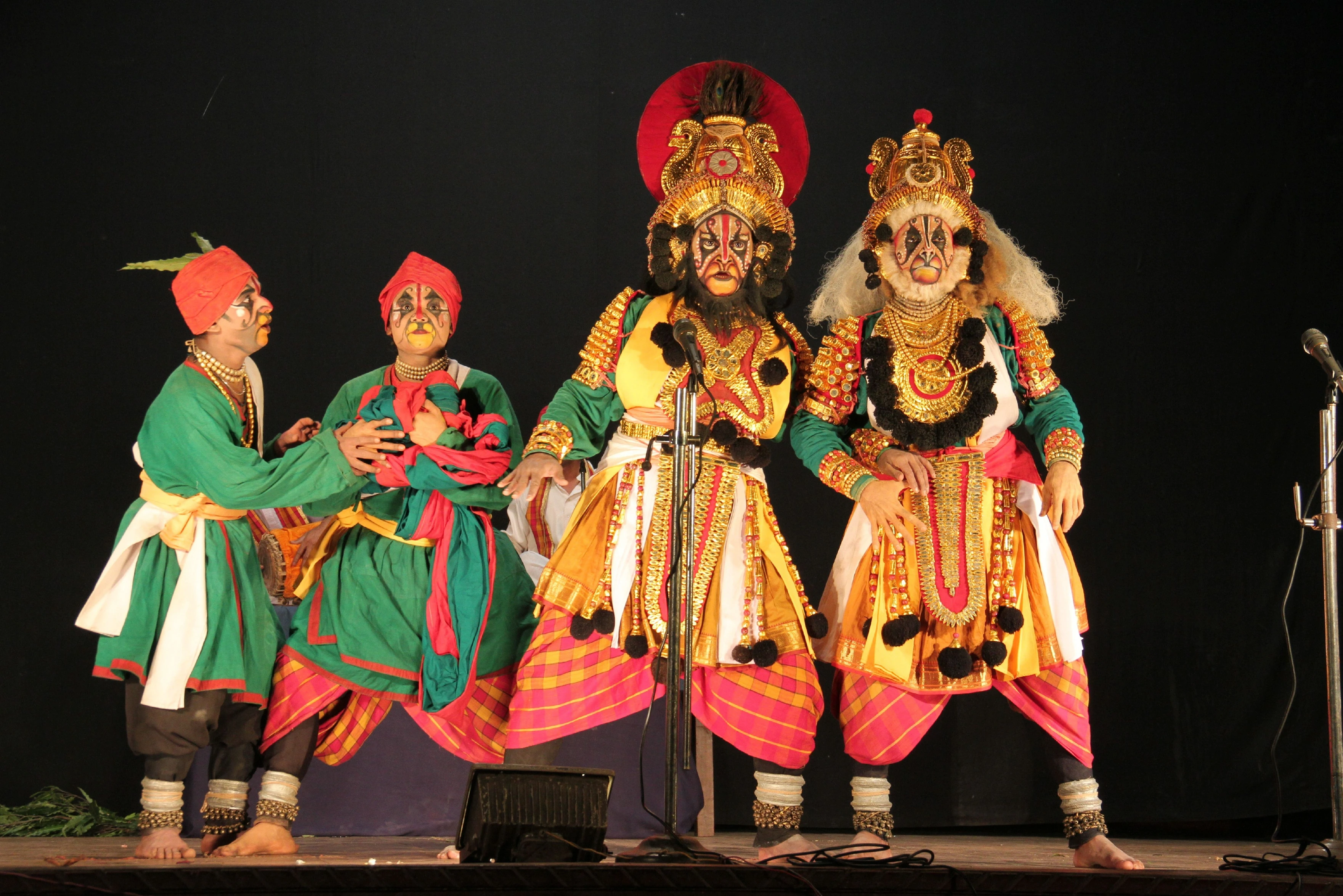
The “Keremane Shambhu Hegde National Performing Arts Festival” has been a monumental success. However, organizing it is not without challenges. Securing funding is a significant hurdle, and it’s often a task to convince potential sponsors about the festival’s value. Despite these challenges, we’ve remained committed to keeping the festival non-ticketed, ensuring it remains accessible to everyone. The festival’s reputation has grown over the years, attracting artists who are eager to perform amidst the village’s natural beauty and rich cultural backdrop.
Yakshagana in a Globalized and Digital World
The future of Yakshagana, in the face of increasing globalization and digitalization, looks promising. The art form is gaining traction and reaching wider audiences, not just within India but globally. In today’s fast-paced world, not everyone might sit through an entire Yakshagana performance, but there’s a growing interest in learning about it. For many outside our traditional audience, Yakshagana offers a fresh and intriguing perspective. Unlike many dance and theatre forms that are strictly scripted, Yakshagana thrives on improvisation. This dynamic nature of the art form makes it relatable and relevant, not just in the realm of performing arts but in various facets of life.
The ability to improvise is a valuable skill, whether in the arts, in business, or in day-to-day interactions. In a corporate setting, for instance, roles can change rapidly. One might be leading a team one day and collaborating as a team member the next. Navigating these shifts requires adaptability and improvisation, much like a Yakshagana performance.
Moreover, Yakshagana emphasizes non-verbal communication, a universal language that transcends cultural and linguistic barriers. This aspect of the art form has piqued interest worldwide, leading to workshops and outreach programs that introduce more people to its beauty and depth.
Writers and scholars, intrigued by the art form, are delving deeper, further promoting its significance and relevance in today’s world. Personal journeys, like mine, where I transitioned from neuroscience to fully embracing Yakshagana, underscore its profound impact.
Challenges of Preserving Yakshagana in the Modern Era
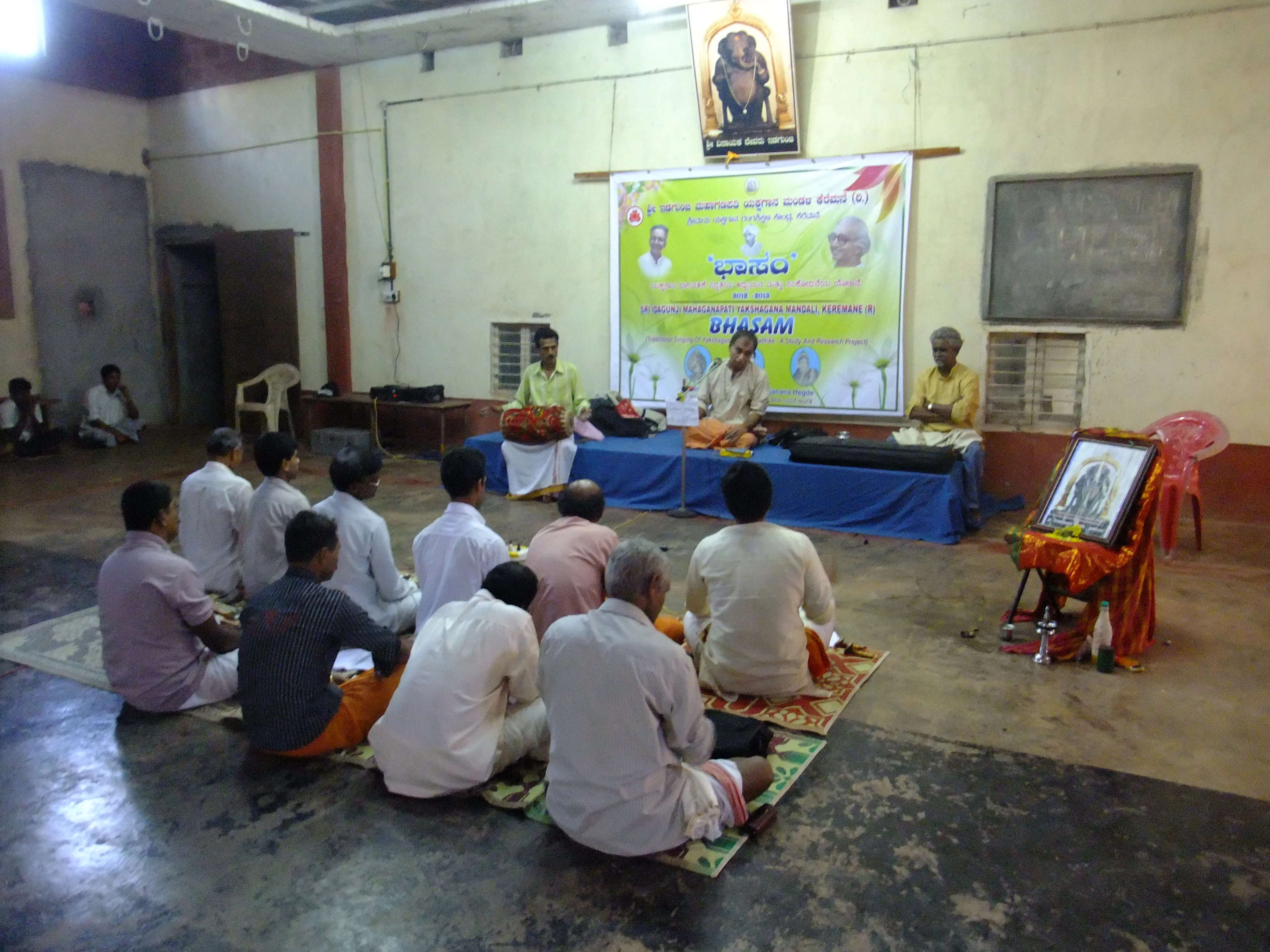
Keeping the tradition of Yakshagana alive in today’s rapidly changing world is fraught with challenges, both social and economic.
- Recognition and Remuneration: One of the primary issues is the lack of recognition of Yakshagana as a classical art form. This has economic implications. Artists in recognized classical forms like Kathak or Bharatnatyam often receive better remuneration. There’s a noticeable preference among audiences for these forms over Yakshagana. For instance, if there’s a Bharatnatyam performance in our open-air theatre, it tends to draw a larger crowd than a Yakshagana show.
- Reliance on Government Support: Historically, we’ve depended on government grants and support. However, this assistance is unpredictable, making it challenging to sustain the art form.
- Competition from Other Media: With the advent of digital media, people find it more convenient to watch performances from the comfort of their homes. This shift in consumption patterns poses a threat to traditional live performances.
- Balancing Tradition with Modernity: While theatre allows for a lot of flexibility in terms of music and presentation, Yakshagana has its essence rooted in tradition. We face the challenge of updating and choreographing older stories without losing their core essence.
- Gurukula System: Unlike art forms like Kathakali, which have a standardized six-year training period, Yakshagana doesn’t have a fixed curriculum. While we strive to educate our students comprehensively, the lack of a standardized system can sometimes affect the quality of training.
- Quality of Production: Some troupes prioritize commercial success over the art’s integrity, leading to a dilution in the quality of performances.
- Communication Barriers: Many of our artists come from backgrounds where they haven’t received formal education. This poses challenges in communication, especially when interacting with diverse audiences or in settings that require proficiency in multiple languages.
In the face of these challenges, our commitment to Yakshagana remains unwavering. We continuously seek innovative solutions to ensure that this rich and vibrant art form continues to thrive and resonate with audiences, both old and new.
Promoting Yakshagana Among the Younger Generation
For the younger generation to truly support and uplift the tradition of Yakshagana, exposure is key. I’d encourage them to immerse themselves in the art form. This could mean visiting places where performances are held, getting to know the artists personally, and understanding the intricacies of the craft.
If someone has organizational skills or resources, hosting shows or events centred around Yakshagana can be immensely beneficial. In today’s digital age, leveraging social media, creating documentaries, and using other modern tools can help in spreading awareness and appreciation for the art form. Networking, connecting with like-minded individuals, and collaborating with those in the broader realm of arts and culture can further amplify its reach.
Given that we’re in an era of global travel and exchange, exploring and sharing Yakshagana beyond our immediate boundaries can introduce it to a wider audience. The path forward lies in both cherishing the tradition and adapting to modern means of promotion and engagement.
How to reach Gunavante
By Road
Gunavante is accessible via National Highway 66 (NH66) which runs along the western coast of India. If you are travelling from Bangalore, take NH 48 which connects to NH66. Once on NH66, head towards Honavar and then take local roads to reach Gunavante. The best way to reach this village is by booking a Savaari from Bangalore for a comfortable commute.
By Train
The nearest railway station to Gunavante is Honavar Railway Station: Honavar is connected by the Konkan Railway, which links major cities on the west coast. Once you arrive at Honavar, you can hire a taxi or take local transportation to reach Gunavante.
By Flight
The nearest airports to Gunavante are Dabolim Airport in Goa and Mangalore International Airport. After landing, book an airport taxi to reach Honavar and subsequently Gunavante. The drive is approximately 3-4 hours.
Things to do in near Gunavante
Honnavar, a coastal town in Karnataka, is renowned for its stunning landscapes and rich history. Located just 9.1 km from Gunavante, it offers a plethora of activities for visitors. Easily accessible from Bangalore, Mangalore, Goa, and Shimoga, Honnavar is famous for its suspension bridges, waterfalls, coastal cuisine, hiking trails, and mangrove forests, among other attractions. Here are some popular things to do and see in Honnavar:
- Apsarakonda: Apsarakonda, meaning ‘Pond of Angels,’ is a picturesque destination 7 km from Honnavar’s city center. It offers breathtaking views of nature, including a divine sunset over the beach and the Pandavas caves. The area is home to ancient temples like Maha Ganapati temple and Ugra Narasimha temple, surrounded by lush green forests and gushing waterfalls, creating a serene atmosphere. To explore Karnataka’s most stunning waterfalls, be sure to refer to this informative guide.
- Eco Beach: Located 20 km from the famous Murudeshwara Temple, Eco Beach is a ‘Blue Flag’ certified beach in India. Previously known as Kasargod Beach, it is a tranquil and eco-friendly spot ideal for families, women travellers, and anyone seeking a peaceful time in nature. The beach, jointly developed by the Kasargod Village Forest Committee and the forest & Tourism department, offers various activities and amenities for visitors.
- Kodlamane Shree Vishnumurthy Temple: This temple dedicated to Lord Vishnu is a hidden gem in Karnataka. Located in Honnavar taluka of the Uttar Kannada district, it is known for its Vedic Hindu architecture and the Garuda Stambha at the main gate. The temple holds religious significance and is a pilgrimage site for many.
- Basavaraj Durga Islands: Dating back to the 16th century, the Basavaraj Durga Fort and temple on an island are must-visit attractions. Situated about 7 km from the main town, the temple can be reached by boat, crossing the Arabian Sea through River Sharavathi. Legends say it was constructed by rulers of the 16th and 17th centuries.
- Sharavathi Kandla Mangrove Boardwalk: Also known as Kandla Vana, this Mangrove Boardwalk is a recent addition to Honnavar’s tourist attractions. It’s an excellent place to explore and connect with nature, maintained by the Karnataka Forest Department. Located approximately 3 km from Honnavar, just opposite Eco Beach, it’s an educational spot with informative signboards about the region’s flora and fauna.
Why choose Savaari to travel to witness Yakshagana?
Savaari recognizes the immense cultural wealth and diverse artistic expressions that India offers. Every corner of the country tells a story, woven with traditions, rituals, and art forms that have evolved over centuries. At the heart of Savaari’s mission is the belief that travel isn’t just about moving from one place to another; it’s about immersing oneself in these stories and experiencing the depth of India’s cultural heritage.
With Savaari’s commitment to providing seamless connectivity, even to the most remote locations, they are not just offering a mode of transport but an invitation. An invitation to delve deep into the myriad art forms that give each Indian state its unique identity. Yakshagana is so profound and mesmerizing that it alone can be a compelling reason for someone to visit Gunavante.
By making the booking process as simple as a tap by downloading the Savaari app, Savaari ensures that the beauty of such art forms remains accessible to all. It’s not just about convenience; it’s about bridging the gap between curious travellers and the rich tapestry of arts that India has to offer. In essence, when you choose Savaari, you’re not just choosing a ride; you’re choosing an experience, an exploration, and a journey into the heart of what makes India truly incredible.
Last Updated on November 15, 2023 by Shabari Shankar
